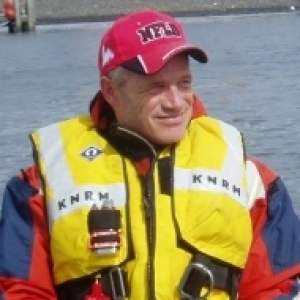Contradiction
If I log in to the Internet on board, I can see via the satellite (40.000 km up and down alltogether) what the speed and heading of the Retriever 75 meter abeam of me is. Satellites measuring the waveheights, currents and watertemperatures up to tenths from space. I can see through a webcam via the same satellite my daughter bicycling in the street. There is no more No, everything is possible or will be made possible. It is a giant leap back in time to come across this piece of equipment on board. Probably never used since the newbuilding, but nevertheless; it is on board. It is a sounding lead and I think it is together with a compass, the oldest navigation instrument in the world. It was used on sailing vessels.
The lead line, for a hand lead, is usually sixty fathoms in length and is made of well-stretched American or Italian hemp, untarred.
The markings of the hand lead are as follows:
2 Fathoms from the lead; 2 strips of leather
3 Fathoms from the lead ; 3 strips of leather
5 Fathoms from the lead ; White cotton rag
7 Fathoms from the lead : Red woolen rag
10 Fathoms from the lead : Leather with a hole
13 Fathoms from the lead : Same as 3 fathoms
15 Fathoms from the lead : Same as 5 fathoms
17 Fathoms from the lead : Same as 7 fathoms
20 Fathoms from the lead : Small line with 2 knots
25 Fathoms from the lead : Small line with 1 knot
30 Fathoms from the lead : Small line with 3 knots
35 Fathoms from the lead : Small line with 1 knot
40 Fathoms from the lead : Small line with 4 knots
and so on, a mark at each five fathoms. These are known as the marks of the lead line. The fathoms not marked are known as the deeps of the leadline.
Casting the lead
Taking soundings, or casts of the lead, is done when the vessel has headway on, the leadsman casting the lead forward and getting the depth as the vessel passes over the lead, resting on the bottom.
The leadsman grasps the leadline at the toggle and swings the lead back and forth, parallel with the side of the ship, the lead is sent over head for two full turns and released at the bottom of the swing flying forward at a tangent, and almost parallel with the surface of the water. As the line flows out and the lead reaches the bottom, the leadsman grasps the running line with his right hand and pulls it rapidly plunging it up and down to feel the bottom. Feeling bottom, he plumbs the line up and down as the ship passes by the lead. He bends over and notes the mark above the water. The leadsman sings out the marks and deeps. He never uses "sir" as some are apt to do. The soundings should be called out sharp and clear.
Sounding at Night
The leadsman, working in darkness, must know the distance from his waist to the waterline. He reads the mark closest to his waist by feel (or in cold weather by touching the mark to his lips or tongue which are more sensitive than cold fingers) and then subtracts this distance from his depth. Only the exact water depth is cried to the bridge.
Our apprentice could not believe that we still have this line on board, and to be honest neither do I.
- 0
- 0
- Nikon D300
- 1/3
- f/9.0
- 120mm
- 200

Comments
Sign in or get an account to comment.


